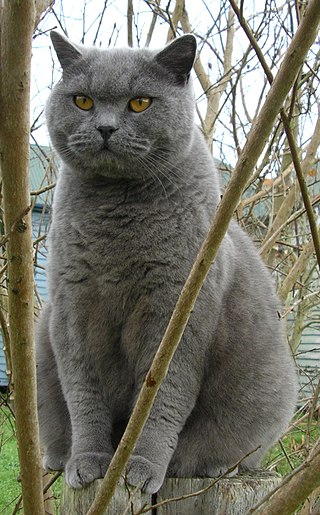
The British Shorthair is the pedigreed version of the traditional British domestic cat, with a distinctively stocky body, thick coat, and broad face. The most familiar colour variant is the "British Blue", with a solid grey-blue coat, pineapple eyes, and a medium-sized tail. The breed has also been developed in a wide range of other colours and patterns, including tabby and colourpoint.
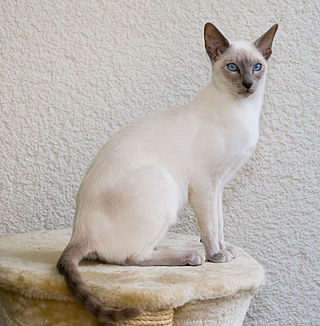
The Siamese cat is one of the first distinctly recognised breeds of Asian cat. Derived from the Wichianmat landrace, one of several varieties of cats native to Thailand, the original Siamese became one of the most popular breeds in Europe and North America in the 19th century. Siamese cats have a distinctive colourpoint coat, resulting from a temperature-sensitive type of albinism.

The Exotic Shorthair is a breed of cat developed as a short-haired version of the Persian. The Exotic is similar to the Persian in appearance with the exception of the short dense coat.

The Cymric is a Canadian cat breed. Some cat registries consider the Cymric a semi-long-haired variety of the Manx breed, rather than a separate breed. Except for the length of fur, in all other respects, the two varieties are the same, and kittens of either sort may appear in the same litter. The name comes from Cymru, the indigenous Welsh name of Wales, even though the breed is not associated with Wales. The name may have been chosen to provide a "Celtic" sounding moniker for the breed. While the breed's Manx bloodline originated from the Isle of Man, the long-haired variant is claimed to have been developed by Canada. The breed is called the Longhair Manx or a similar name by some registries.

The American Bobtail is an uncommon breed of domestic cat which was developed in the late 1960s. It is most notable for its stubby "bobbed" tail about one-third to one-half the length of a normal cat's tail. This is the result of a cat body type genetic mutation affecting the tail development, similar to that of a Manx cat. The breed is not related to other short-tailed breeds, such as the Cymric cat, or the Japanese Bobtail or Kurilian Bobtail, despite the similar name and physical type—the breeding programs are entirely unrelated, and the genetic mutation causing the bobbed tail are known to be different, as the mutation causing the American Bobtail's short tail is dominant; comparatively, the Japanese Bobtail, for example, has a tail mutation that is recessive.

The Javanese, also known as the ColorpointLonghair in some registries, is a variety of purebred domestic cat.

The Oriental Shorthair is a breed of domestic cat that is developed from and closely related to the Siamese cat. It maintains the modern Siamese head and body type but appears in a wide range of coat colors and patterns. Like the Siamese, Orientals have almond-shaped eyes, a triangular head shape, large ears, and an elongated, slender, and muscular body. Their personalities are also very similar. Orientals are social, intelligent, and many are rather vocal. They often remain playful into adulthood, with many enjoying playing fetch. Despite their slender appearance, they are athletic and can leap into high places. They prefer to live in pairs or groups and also seek human interaction. Unlike the breed's blue-eyed forebear, Orientals are usually green-eyed. The Oriental Longhair differs only with respect to coat length.

The European Shorthair, called the European in FIFe and Celtic/European Shorthair in WCF, is a breed of cat. The term has also been used as an elaborate way of referring to common domestic short-haired cats of Europe, causing some confusion as the pedigree cats of this breed also should resemble the typical domestic cats of Europe.
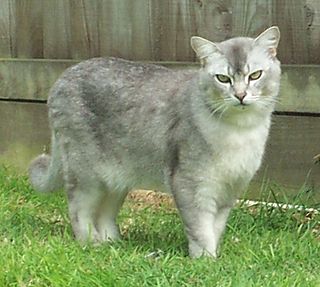
The Burmilla is a breed of domestic cat, that originated in the United Kingdom in 1981. It is a cross between the Chinchilla Persian and Burmese cats. In certain cat registries the breed falls under the Asian group, and is sometimes referred to as the Asian Shaded. Standards were produced in 1984, and the breed gained championship status in the United Kingdom in the 1990s.

The Tiffanie is a cat breed similar to the Asian Shorthair except it has semi-long fur length. The breed belongs to the Asian Group and is generally recognised in any of the Asian Shorthair or Burmese colours and patterns. Like the other cats in the Asian Group, the breed was developed during the 1980s in the United Kingdom by crossbreeding a Persian Chinchilla and a Burmese.
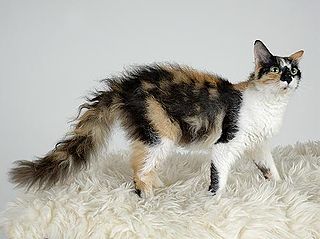
The LaPerm is a breed of cat. A LaPerm's fur is curly, with the tightest curls being on the throat and on the base of the ears. LaPerms come in many colors and patterns. LaPerms generally have a very affectionate personality.
A cat registry or cat breed registry, also known as a cat fancier organization, cattery federation, or cat breeders' association, is an organization that registers domestic cats of many breeds, for exhibition and for breeding lineage tracking purposes. A cat registry stores the pedigrees (genealogies) of cats, cattery names, and other details of cats; studbooks, breed descriptions, and the formal breed standards ; lists of judges qualified to judge at shows run by or affiliated with that registry, and sometimes other information. A cat registry is not the same as a breed club or breed society. Cat registries each have their own rules and usually also organize or license (sanction) cat shows. The show procedures vary widely, and awards won in one registry are not normally recognized by another. Some registries only serve breeders, while others are oriented toward pet owners and provide individual as well as cattery memberships, while yet others are federations only deal with breed clubs or even other registries as intermediaries between the organization and breeders.

The Asian or Asian group, is a cat breed similar to the European Burmese but in a range of different coat colours and patterns. Long-haired Asians of all varieties are called Tiffanies. Asians are grouped in section 5 (Burmese) by the Governing Council of the Cat Fancy.

The Thai or Wichien Maat is a newly renamed but old cat breed, related to but different from the Western, modern-style Siamese cat. This natural breed is descended from the cats of Thailand, and, among various groups of breeders in different times and places has also been called the Old-Style Siamese, Traditional Siamese, Classic Siamese; Wichien Maat ; and the Applehead, a nickname that originated in the 1950s. According to The International Cat Association: "The Thai is the breed dedicated to preserving the native pointed cat of Thailand in as close to its original form as possible."

The British Longhair is a medium-sized, semi-long-haired breed of domestic cat, originating in Great Britain.

The Kurilian Bobtail is a cat breed originating from the Russian Kuril Islands, as well as Sakhalin Island and the Kamchatka peninsula of Russia. Short- or long-haired, it has a semi-cobby body type and a distinct short, fluffy tail. The back is slightly arched with hind legs longer than the front, similar to those of the Manx. The breed is also called the Kuril Islands Bobtail, Kuril Bobtail and Curilsk Bobtail, and may be referred to without "Bobtail". It is sometimes also spelled Kurilean. The original short-haired variant is a natural breed, known on the islands for over 200 years. As selectively bred pets, they have been popular in USSR and to some extent other parts of Europe, especially for their rodent-hunting abilities, since the middle of the 20th century, but remained rare in North America as of 2011.
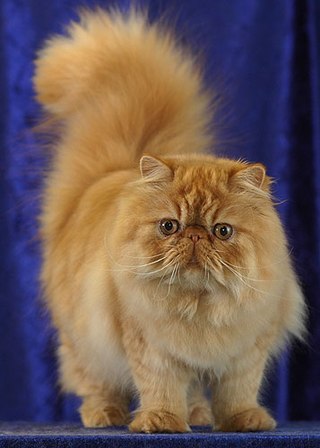
The Persian cat, also known as the Persian Longhair, is a long-haired breed of cat characterised by a round face and short muzzle. The first documented ancestors of Persian cats might have been imported into Italy from Khorasan as early as around 1620, however, this has not been proven. Instead, there is stronger evidence for a longhaired cat breed being exported from Afghanistan and Iran from the 19th century onwards. Widely recognised by the North-West European cat fancy since the 19th century, and after World War II by breeders from North America, Australia and New Zealand. Some cat fancier organisations' breed standards subsume the Himalayan and Exotic Shorthair as variants of this breed, while others generally treat them as separate breeds.

Cyprus cats, also known as Cypriot cats, Saint Helen cats, and Saint Nicholas cats, are a landrace of domestic cat found across the island of Cyprus. A standardized breed is being developed from them; among cat fancier and breeder organizations, it is presently fully recognized by the World Cat Federation (WCF), with breeding regulated by the World Cat Congress (WCC), under the name Aphrodite's Giant; and provisionally by The International Cat Association (TICA) as the Aphrodite. All three organizations permit shorthaired and semi-longhaired versions and no out-crossing to other breeds.

































